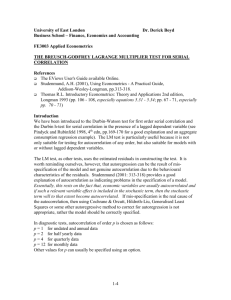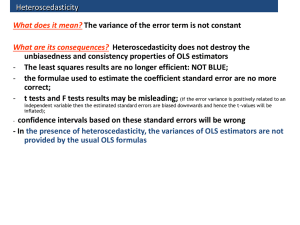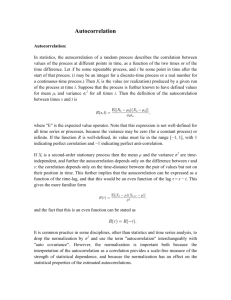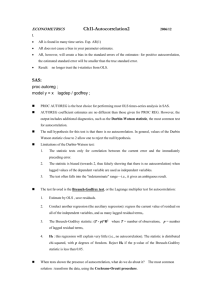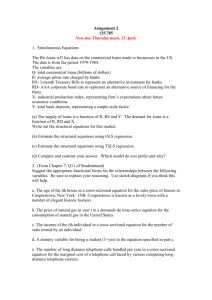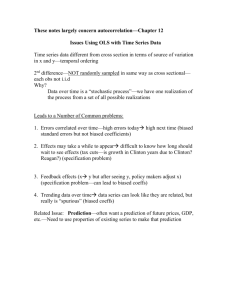Autocorrelation - Personal Home Pages (at UEL)
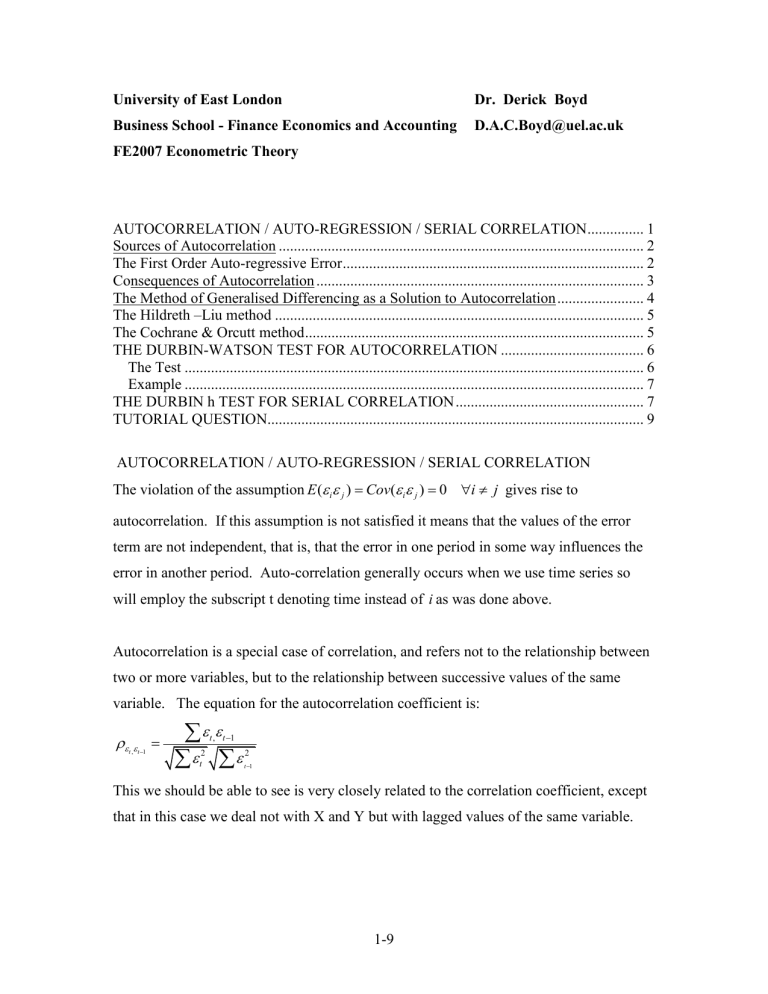
University of East London Dr. Derick Boyd
Business School - Finance Economics and Accounting D.A.C.Boyd@uel.ac.uk
FE2007 Econometric Theory
AUTOCORRELATION / AUTO-REGRESSION / SERIAL CORRELATION ............... 1
Sources of Autocorrelation ................................................................................................. 2
The First Order Auto-regressive Error ................................................................................ 2
Consequences of Autocorrelation ....................................................................................... 3
The Method of Generalised Differencing as a Solution to Autocorrelation ....................... 4
The Hildreth –Liu method .................................................................................................. 5
The Cochrane & Orcutt method .......................................................................................... 5
THE DURBIN-WATSON TEST FOR AUTOCORRELATION ...................................... 6
The Test .......................................................................................................................... 6
Example .......................................................................................................................... 7
THE DURBIN h TEST FOR SERIAL CORRELATION .................................................. 7
TUTORIAL QUESTION.................................................................................................... 9
AUTOCORRELATION / AUTO-REGRESSION / SERIAL CORRELATION
The violation of the assumption E (
j
)
Cov (
j
)
0 i j gives rise to autocorrelation. If this assumption is not satisfied it means that the values of the error term are not independent, that is, that the error in one period in some way influences the error in another period. Auto-correlation generally occurs when we use time series so will employ the subscript t denoting time instead of i as was done above.
Autocorrelation is a special case of correlation, and refers not to the relationship between two or more variables, but to the relationship between successive values of the same variable. The equation for the autocorrelation coefficient is:
t
1
t , t
1
t
2 t
1
This we should be able to see is very closely related to the correlation coefficient, except that in this case we deal not with X and Y but with lagged values of the same variable.
1-9
Sources of Autocorrelation
1.
Omitted Explanatory Variables If this occurs, since it is known that most economic variables are autocorrelated, then the error will be autocorrelated.
Including the omitted variable into the equation should get rid of this problem.
2.
Misspecification of the Mathematical Form of the Model If we specify a linear form when the true form of the model is non-linear then the errors may reflect some dependence.
3.
Interpolation in the Statistical Observations Most published time series involve some ‘smoothing’ process which averages out the true disturbances over
4.
successive periods – getting rid of seasonal effects in a series, for example – and as a consequence successive values of
t
can become related.
Misspecification of the True Random Error Successive values of
t
may be related due to purely random factors, such as wars, drought, change in taste, … which have an effect over successive periods. In such a case E (
t
j
)
0
0 and the true pattern of the
value will really be misspecified. This may be called t
‘true autocorrelation’ since the root cause of the auto-regressiveness lies in the nature of the error term.
The First Order Auto-regressive Error
A good part of the attention given to autocorrelation has be concerned with a particular form of auto-correlation relationship known as first-order autoregressive errors. This has attracted considerable attention from econometricians.
Let us consider the model:
Y t
=
0
+
1
X
1t
+
2
X
2t
+
t
And suppose
t
=
t-1
+ v t where,
= the autocorrelation coefficient
1 1
.......... (1)
1 ............. (2) v t
= a random error that fulfills the Classical Linear Model assumption.
2-9
This simply says that
lies between –1 and 1 like any correlation coefficient. Note that if
=0, i.e. no serial correlation, the model reverts to the usual CLM with a ‘good’ error term:
Y t
=
0
+
1
X
1t
+
2
X
2t
+ v t
.............. (3)
With the first order autocorrelated error the full specification of the model would really be:
Y t
=
0
+
1
X
1t
+
2
X
2t
+
t-1
+ v t
.............. (4)
With an autocorrelated error term (even a first order error) an error in any past time period is felt in all future periods, but with a magnitude that diminishes over time.
Consequences of Autocorrelation
1.
If the error in a model is autocorrelated the OLS parameter estimates will remain linear.
2.
If the error in a model is autocorrelated the OLS parameter estimates will remain unbiased.
Proof:
We know that we can state the following:
x i
i x i
2
Taking expectations we obtain,
E
x E i
x i
2
i
E
x i
2
where any bias in
€
is measured as
So long as the CLM assumption that E
0 then the bias in
€
will be zero.
Therefore, even if the error term is auto-correlated the OLS parameter estimates will remain unbiased.
3.
The estimated variances of the OLS estimators are biased . Sometimes the usual way of computing s
2
€
s
2
1
x i
2
will seriously underestimate the true variances and
3-9
standard errors, thereby inflating t values. Therefore, the usual t and F tests are not reliable with autocorrelation.
Note, Var
2
1 x i
2
s
2
1
x i
2 where s
2
is an estimator of
2
when unknown. The problem really resides in s
2
as the item that follows explains.
2
is
4.
The variance of the error term may be seriously underestimated (biased), that is the
Residual Sum of Squares =
€ 2 t
may result in the estimate variances being much less than the true variance since: s
2
€ 2 t
N
K
.
5.
As a consequence of the problem with the residual sum of squares, the R 2 is also unreliable with autocorrelation – it will be biased upwards.
The Method of Generalised Differencing as a Solution to Autocorrelation
Generalised differencing allows a transformed equation to be developed from which OLS
BLU estimates can be obtained. The procedure is as follows:
1.
We start with the full specification of the first order autocorrelated error (equation
4).
2.
We lag the equation and multiply it by
thus obtaining (equation 5).
3.
We subtract Eqn. 5 from Eqn 4.
As follows:
1.
2.
Y t
=
0
+
1
X
1t
+
2
X
2t
+
t-1
+ v t
.............. (4)
Y t-1
=
0
+
1
X
1t-1
+
2
X
2t-1
+
2 t-2
+
v t-1
.............. (5)
3. Y t
-
Y t-1
=
0
-
0
+
1
X
1t
-
1
X
1t-1
+
2
X
2t
-
2
X
2t-1
+
+
t-1
-
2 t-2
+ v t
-
v t-1
4.
Y t
-
Y t-1
=
0
(1 -
) +
1
(X
1t
-
X
1t-1
) +
2
(X
2t
-
X
2t-1
) + v t
Since
t-1
-
2 t-2
+ v t
-
v t-1
=
t
-
t-1 order error given above:
t
=
t-1
+ v t
. and by the definition of the first
We can write this in the more familiar form as:
4-9
5.
Y t
*
0
*
X
1 1
*
X *
2 2
v t where
Y t
*
( Y t
Y t
1
)
*
0
0
(1
)
X
1
*
( X
1, t
X
1, t
1
)
X
2
*
( X
2, t
X
2, t
1
)
This now looks like any multiple regression form of the CLM. The only problem is that to construct the variables that are all asterisked (*) we need to have a value for
, and this we do not have.
Obtaining a estimate of
is necessary, therefore, to transforming the model so we dcan obtain a ‘good’ error term and we shall look at two well known methods for doing so: the
Hildreth –Liu method, and the Cochrane & Orcutt method.
The Hildreth –Liu method
The procedure to obtain an estimate of
proposed by Hildreth and Liu is very straightforward and often used.
We know that
1 so we construct variables with various guessed values of
, e.g. –1.0, -0.9, -0.8, -0.7, …-0.1, 0.0, 0.1, 0.2, …. 0.8, 0.9, 1.0 and see which value is associated with the lowest Residual Sum of Squares. We take that value as the best estimate of
and construct the variables with this value. Care has to be taken that the minimum value of the Residual Sum of Squares is the overall minimum value.
The Cochrane & Orcutt method
The procedure for this method is as follows.
1.
Run the regression for the original model.
2.
Take the estimated residuals from the regression and run the equation
€ t
t
€ t
1
v t
here is essentially the intercept term.
5-9
3.
The estimate of
obtained from the equation in 2 is used to construct the asterisked variables and the generalised differenced form is estimated. From this OLS regression we noted the residuals sum of squares.
4.
We take this latter set of residuals and with the aid of the regression model in 2 construct another set of * variables and run the generalised model again with these newly constructed variables and note the residual sum of squares.
5.
We continue to repeat 4 until we observe that the residual sum of squares is not reduced significantly. This will give the best fit of the model.
Some care has to be taken, since the iterations may lead to a local minimum for the residual sum of squares and not a global minimum.
THE DURBIN-WATSON TEST FOR AUTOCORRELATION
By far the most popular test for autocorrelation is the Durbin-Watson test. The ubiquitous DW statistics is to be found on the results pages of any self-respecting statistical package.
The DW test is applicable to small samples.
The test is only applicable to first order Autoregressive systems.
It is not applicable if there is a lagged endogenous variable. In this case the Durbin h test should be applied.
The Test
The null hypothesis
The alternative hypothesis
Ho:
= 0
Ha:
0
To test the hypothesis DW calculates an estimate of
from the regression residuals:
DW
t
N
2
(
€ t
1
)
2 t
N
1
€ 2 t
6-9
The DW statistics lies in the range zero to 4:
0
DW
4 .
It can be shown that,
DW
2(1
)
0 ( no serial correlation) DW = 2.
tends to 1 ( perfect positive first order serial correlation) DW = 0.
tends to -1 ( perfect negative first order serial correlation) DW = 4.
Critical values for DW tests can be obtained from published tables to be found in the back of econometric texts. Lower and upper limits are usually defined because the sequence of the error terms depends not only on the sequence of residuals but also on the sequence of all the X values. Different assumption are therefore used to calculate values under assumptions. Thus, there are three decisions regions to this test. In addition to the do not reject the null hypothesis and the reject the null hypothesis , there is also an area of indecision when the test can neither be rejected or not rejected .
Example
Let us consider an example from Gujarti’s Essentials (p. 364) Demand for Chicken.
The DW = 1.8756 N = 23, K = 2 excluding the intercept.
The critical values are D
L
= 1.168 D
U
= 1.543 at 5%.
In this case we would NOT reject the null hypothesis of no autocorrelation since 1.8756 is not statistically different to 2 at 5%.
THE DURBIN h TEST FOR SERIAL CORRELATION
TESTING FOR SERIAL CORRELATION IN MODELS WITH LAGGED
DEPENDENT VARIABLES
When one or more lagged dependent variables are present, the DW statistic wil be biased towards 2 – this means that even if serial correlation is present it may be close to 2.
7-9
Durbin suggests a test that is strictly valid for large sample but often used for small samples. This test for serial correlation when there is a lagged dependent variable in the equation is based on the h statistics.
It’s a fairly straightforward procedure.
Assume we estimated this model with OLS:
Y t
X t
Y t
1
t
The Durbin h statistics is defined as: h
T
1
T Var
€
T = the number of observations,
= the estimated correlation coefficient of the residuals, that is the autocorrelation coefficient of the residuals.
The Var
is the variance of the coefficient on the lagged dependent variable.
and substituting we can write the h statistics as: h
1
DW
2
T
1
T Var
€
Durbin has shown that the h statistics is approximately normally distributed with a unit variance, hence the test for first order serial correlation can be done using the standard normal distribution. It should be noted, however, that if T Var
€
is greater than one, then the ratio with the square root becomes negative and this test cannot be applied.
So, the test is a normal distribution Z test and the null hypothesis is that
0 .
In an example to be found in Pindyck and Rubinfeld (3 rd
edition p.149, 4 th
edition p.169 – details in Unit Guide) an aggregate consumption function is estimated with the dependent variable lagged one period as an explanatory variable. The results obtained are:
8-9
YD t
0.911
C t
1
(4.49) (.028) (.0304)
DW=1.569 R 2 = 0.999 h = 2.79 T = 147
We may observe that h may be calculated as: h
1
1.569
2
147
2
2.79
Since 2.79 is greater than the critical value of the normal distribution at the 5% level (the critical value is 1.645 for a one tail test with 5% in the tail), we reject the null hypothesis of no serial correlation. As a result, it is important to correct for serial correlation in the estimation of this dynamic aggregate consumption function.
TUTORIAL QUESTION
Carry out the h test in the above example as a two-tailed test at 5% significance level.
From a recent past examination paper do the question on autocorrelation that appears on the paper.
********
9-9
